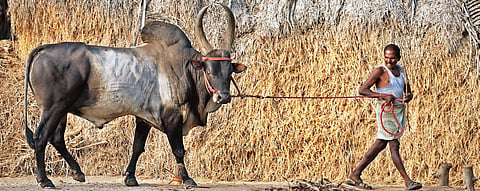

COIMBATORE: Last year during the same period, Tamil Nadu had witnessed a Statewide uprising, particularly by the youth, against the ban on traditional sport Jallikattu. The movement triggered an interest among the youngsters to protect and preserve the heritage and culture of the land. The awareness generated among them to safeguard rare native cattle breeds has not waned even after a year, and in fact many youngsters, particularly students and IT professionals, have started rearing native cattle, in particular the Kangeyam breed.
Kangeyam cattle has both cow and bull varieties. During the 1940s, there were arould 34 lakh Kangeyam cattle and but by the 1990s, their numbers had come down to approximately 11 lakh and 74 thousand. In 2001, the figures were an alarming 4 lakh. At present, there are just 1.5 lakh cows and 700 stud bull varieties.
Some of the renowned industrialists from the Kongu region are helping in breeding of bulls, says Karthikeya Sivasenapathy, managing trustee of the Senapathy Kangeyam Cattle Research Foundation (SKCRF). He also says the Jallikattu protests have played a vital role in creating awareness among all age groups, in particular, youngsters. Around 100 college students across the State have purchased cows and most of them belong to Coimbatore and Tiruppur districts.
V Soorya, a second year BCom student of Loyala College in Chennai, is among those to have bought Kangeyam cattle recently. He rears them at his farm land in native village of Tirumuruganpoondi in Tiruppur. He says, “Even as a child, I had an interest in rearing cattle breeds. After Jallikattu protests, the interest became stronger. I have purchased two Kangeyam cows and now a calf too has joined our family. Apart from cattle breeding, I have also started concentrating on organic farming and we are undertaking cultivation of vegetables in our land at Tiruppur. My parents take care of the cow when I leave for Chennai for studies. During the vacation, I spend most of the time with the cows and in farming activities.”
“Awareness about organic farming is increasing, which is a good sign. Youngsters should show more interest in safeguarding native cattle breeds as well.”
Know the breeds
Across South India, nattu madu (country cattle) breeds are divided into three categories. The first type is cattle that give more milk, the second is dual-purpose cattle that provide milk and can perform a variety of other tasks, and the third is draft animals. This type of cattle is suitable for work and gives very less milk, explains Sivasenapathy.
The cattle in Tamil Nadu, Karnataka, and some parts of Maharastra are classified as ‘Mysore type draft’ animals. While Halikar and Amrith Mahal in Karnataka and Krishnaraly Kilary in Maharastra are examples of this type of cattle, in Tamil Nadu, breeds such as, Umblacherry, Burgur Malai Madu, Pulikulam, Tirunelveli Kuttai Madu and Thondai Mandala Kuttai are all considered native breeds.
“In Tamil Nadu, among all breeds, Kangeyam breed is considered as the best. Genetic studies done by the Tamil Nadu Veterinary and Animal Science University revealed that all cattle breeds in Tamil Nadu evolved from Kangeyam cattle. These are the father and mother of all the cattle in the State. This is one of the main reasons why Kangeyam has become so famous,” Sivasenapathy says.
Lands are crucial too
In Ollapalayam on the Kangeyam –Trichy Highway, each year, during the temple festival held in April, a cattle show is conducted in a very grand manner. Previously there used to be more than one lakh cattle in the show, whereas now, it is a mere 5,000. “After 2010, we have taken many steps to ensure youngsters attend the cattle show. Korangadu is the unique type of land that supports grazing of Kangeyam breed. Korangadu is a unique silvi-pasture grazing system in western Tamil Nadu,” he adds.
In other parts of the State, only vacant Government lands are used for cattle grazing, whereas here, private lands are also used. “There are two types and seven varieties of grass in Korangadu. It has been naturally established over centuries. Kolukattai grass variety is the most unique. This has more calcium and keeps the cattle free of bone-related diseases. It is also beneficial for those who consume the milk.”
The Tamil Nadu government has been taking steps to establish a farm for cattle.
Sivasenapathy has requested the government to establish the farm at Kangeyam instead of Sathyamangalam. “We have established the SKCRF at Kuttapalyam in Tirupur district to protect the native breed and conserve native land. We are also conducting cattle shows, and have a breeding program. Training, documentation, outreach and various activities are carried out. After Jalikattu protests, thousands have visited the SKCRF premises,” he says. With a steep rise in interest in the breed, he is hopeful people finally step in and safeguard Kangeyam cows and bulls.
The breed
Derives its name from the Kangeyam town located in Tiruppur district
Considered a good draught breed
Kangeyam cattle is on decline, as it has lost out to breeds that give more milk
It is extensively used in Jallikattu owing to its aggressive nature
Bulls can weigh as much as 1,150 pounds
Many fear it could go the way of Alambadi, a similar breed that is now considered extinct